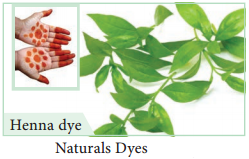Learninsta presents the core concepts of Biology with high-quality research papers and topical review articles.
Definition Of Dye | Henna and Its Uses
The ability to perceive colour is a wonderful aspect of human eyes and dyes add colour to the goods we use. They have been in use since the ancient times.
The earliest authentic records of dyeing were found in the tomb painting of ancient Egypt. Colourings on mummy cements (wrapping) included saffon and indigo. They can also be seen in rock paintings in India.
Henna
Botanical name: Lawsonia inermis
Family: Lythraceae
Origin and Area of cultivation:
It is indigenous to North Africa and South-west Asia. It is grown mostly throughout India, especially in Gujarat, Madya Pradesh and Rajasthan.
Uses
An orange dye ‘Henna’ is obtained from the leaves and young shoots of Lawsonia inermis. The principal colouring matter of leaves ‘lacosone’ is harmless and causes no irritation to the skin. This dye has long been used to dye skin, hair and finger nails. It is used for colouring leather, for the tails of horses and in hair-dyes.
